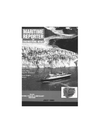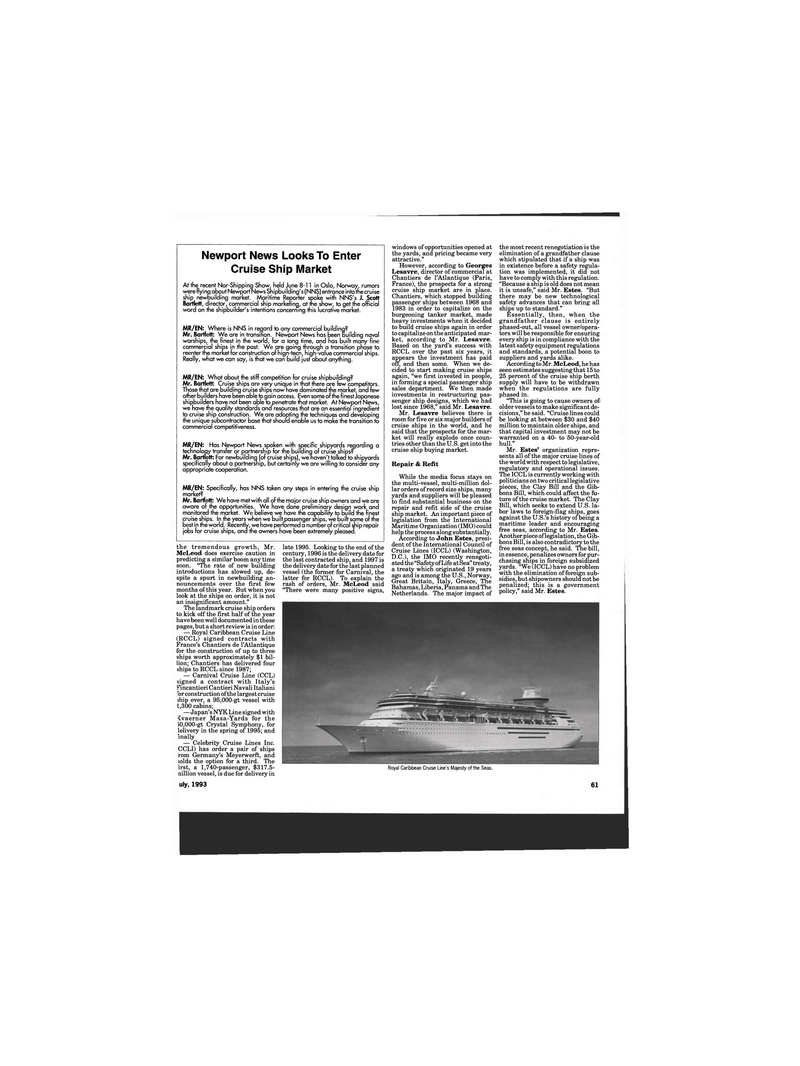
Page 61: of Maritime Reporter Magazine (July 1993)
Read this page in Pdf, Flash or Html5 edition of July 1993 Maritime Reporter Magazine
Newport News Looks To Enter
Cruise Ship Market
At the recent Nor-Shipping Show, held June 8-11 in Oslo, Norway, rumors were flying about Newport News Shipbuilding's (NNS) entrance into the cruise ship newbuilding market. Maritime Reporter spoke with NNS's J. Scott
Bartlett, director, commercial ship marketing, at the show, to get the official word on the shipbuilder's intentions concerning this lucrative market.
MR/EN: Where is NNS in regard to any commercial building?
Mr. Bartlett: We are in transition. Newport News has been building naval warships, the finest in the world, for a long time, and has built many fine commercial ships in the past. We are going through a transition phase to reenter the market for construction of hign-tecn, high-value commercial ships.
Really, what we can say, is that we can build just about anything.
MR/EN: What about the stiff competition for cruise shipbuilding?
Mr. Bartlett: Cruise ships are very unique in that there are few competitors.
Those that are building cruise ships now have dominated the market, and few other builders have been able to gain access. Even some of the finest Japanese shipbuilders have not been able to penetrate that market. At Newport News, we have the quality standards and resources that are an essential ingredient to cruise ship construction. We are adopting the techniques and developing the unique subcontractor base that should enable us to make the transition to commercial competitiveness.
MR/EN: Has Newport News spoken with specific shipyards regarding a technology transfer or partnership for the building of cruise ships?
Mr. Bartlett: For newbuilding (of cruise ships), we haven't talked to shipyards specifically about a partnership, but certainly we are willing to consider any appropriate cooperation.
MR/EN: Specifically, has NNS taken any steps in entering the cruise ship market?
Mr. Bartlett: We have met with all of the major cruise ship owners and we are aware of the opportunities. We have done preliminary design work and monitored the market. We believe we have the capability to build the finest cruise ships. In the years when we built passenger ships, we built some of the best in the world. Recently, we have performed a number of critical ship repair jobs for cruise ships, and the owners have been extremely pleased. the tremendous growth, Mr.
McLeod does exercise caution in predicting a similar boom any time soon. "The rate of new building introductions has slowed up, de- spite a spurt in newbuilding an- nouncements over the first few months of this year. But when you look at the ships on order, it is not an insignificant amount."
The landmark cruise ship orders to kick off the first half of the year have been well documented in these pages, but a short review is in order: — Royal Caribbean Cruise Line (RCCL) signed contracts with
France's Chantiers de l'Atlantique for the construction of up to three ships worth approximately $1 bil- lion; Chantiers has delivered four ships to RCCL since 1987; — Carnival Cruise Line (CCL) signed a contract with Italy's
Fincantieri Cantieri Navali Italiani !br construction of the largest cruise ship ever, a 95,000-gt vessel with 1,300 cabins; —Japan's NYK Line signed with kvaerner Masa-Yards for the 50,000-gt Crystal Symphony, for lelivery in the spring of 1995; and inally — Celebrity Cruise Lines Inc.
CCLI) has order a pair of ships rom Germany's Meyerwerft, and tolds the option for a third. The irst, a 1,740-passenger, $317.5- nillion vessel, is due for delivery in late 1995. Looking to the end of the century, 1996 is the delivery date for the last contracted ship, and 1997 is the delivery date for the last planned vessel (the former for Carnival, the latter for RCCL). To explain the rash of orders, Mr. McLeod said "There were many positive signs, windows of opportunities opened at the yards, and pricing became very attractive."
However, according to Georges
Lesavre, director of commercial at
Chantiers de l'Atlantique (Paris,
France), the prospects for a strong cruise ship market are in place.
Chantiers, which stopped building passenger ships between 1968 and 1983 in order to capitalize on the burgeoning tanker market, made heavy investments when it decided to build cruise ships again in order to capitalize on the anticipated mar- ket, according to Mr. Lesavre.
Based on the yard's success with
RCCL over the past six years, it appears the investment has paid off, and then some. When we de- cided to start making cruise ships again, "we first invested in people, in forming a special passenger ship sales department. We then made investments in restructuring pas- senger ship designs, which we had lost since 1968," said Mr. Lesavre.
Mr. Lesavre believes there is room for five or six major builders of cruise ships in the world, and he said that the prospects for the mar- ket will really explode once coun- tries other than the U.S. get into the cruise ship buying market.
Repair & Refit
While the media focus stays on the multi-vessel, multi-million dol- lar orders of record size ships, many yards and suppliers will be pleased to find substantial business on the repair and refit side of the cruise ship market. An important piece of legislation from the International
Maritime Organization (IMO) could help the process along substantially.
According to John Estes, presi- dent of the International Council of
Cruise Lines (ICCL) (Washington,
D.C.), the IMO recently renegoti- ated the "Safety of Life at Sea" treaty, a treaty which originated 19 years ago and is among the U.S., Norway,
Great Britain, Italy, Greece, The
Bahamas, Liberia, Panama and The
Netherlands. The major impact of the most recent renegotiation is the elimination of a grandfather clause which stipulated that if a ship was in existence before a safety regula- tion was implemented, it did not have to comply with this regulation. "Because a ship is old does not mean it is unsafe," said Mr. Estes. "But there may be new technological safety advances that can bring all ships up to standard."
Essentially, then, when the grandfather clause is entirely phased-out, all vessel owner/opera- tors will be responsible for ensuring every ship is in compliance with the latest safety equipment regulations and standards, a potential boon to suppliers and yards alike.
According to Mr. McLeod, he has seen estimates suggesting that 15 to 25 percent of the cruise ship berth supply will have to be withdrawn when the regulations are fully phased in. "This is going to cause owners of older vessels to make significant de- cisions," he said. "Cruise lines could be looking at between $30 and $40 million to maintain older ships, and that capital investment may not be warranted on a 40- to 50-year-old hull."
Mr. Estes' organization repre- sents all of the major cruise lines of the world with respect to legislative, regulatory and operational issues.
The ICCL is currently working with politicians on two critical legislative pieces, the Clay Bill and the Gib- bons Bill, which could affect the fu- ture of the cruise market. The Clay
Bill, which seeks to extend U.S. la- bor laws to foreign-flag ships, goes against the U.S.'s history of being a maritime leader and encouraging free seas, according to Mr. Estes.
Another piece of legislation, the Gib- bons Bill, is also contradictory to the free seas concept, he said. The bill, in essence, penalizes owners for pur- chasing ships in foreign subsidized yards. "We (ICCL) have no problem with the elimination of foreign sub- sidies, but shipowners should not be penalized; this is a government policy," said Mr. Estes.
Royal Caribbean Cruise Line's Majesty of the Seas.
July, 1993 61

 60
60

 62
62
